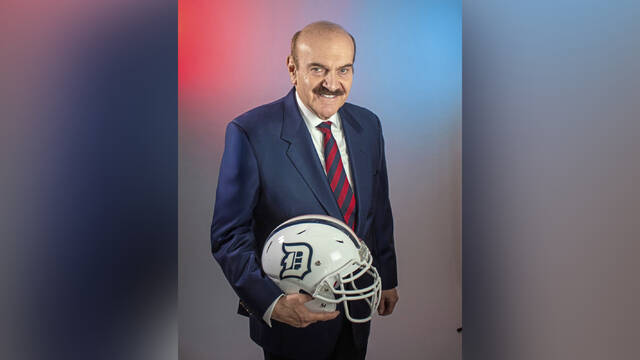https://triblive.com/sports/fox-chapel-author-details-the-rebirth-and-rise-of-duquesne-university-football/
Fox Chapel author details 'The Rebirth and Rise of Duquesne University Football'

It was 1969 when a group of college-aged boys gathered in St. Martin’s Hall at Duquesne University to ignite a grassroots effort to return football to the Bluff.
Fox Chapel resident Sam Costanzo helped draw up the game plan – and said it was sheer industriousness and passion that led “his team” to victory.
“We did it for the love of the game,” said Costanzo, who details the efforts in a new book, “Renaissance: The Rebirth and Rise of Duquesne University Football.”
It was released this month by Word Association Publishers in Tarentum, in conjunction with the first Duquesne-Pitt football game in 87 years. The Dukes and the Panthers are scheduled to meet on the gridiron at Acrisure Stadium on Aug. 30, for the first time since 1939, to open the 2025 season.
Net proceeds from the book will provide football scholarships to Duquesne University student-athletes.
Reviving intercollegiate football after a nearly two-decade absence wasn’t an easy feat, especially for a group of 19-year-olds operating from a front office on the 13th floor of a dorm.
The Duquesne Dukes were a national powerhouse in the 1920s and ‘30s, winning two bowl games, including the 1937 Orange Bowl. But costs associated with World War II halted the program and led to its discontinuation after the 1950 season.
Hiring coaches, securing field time and equipment – “those were all serious challenges,” said Costanzo, who was born and raised in Blawnox and graduated from Fox Chapel Area High School.
Costanzo served on the university’s athletic committee, which proposed to the university a non-scholarship league to keep expenses low. But the effort still required a perfect mix of elements to get the team back on the field.
“We had a committed university administration, savvy management, talented players, outstanding coaches and devoted fans that came into play once the Athletic Committee approved football as a student-run club,” he said.
Ken Gormley, Duquesne president, said in a release that “Nowhere is student engagement and leadership more evident than in the story of the Duquesne Dukes football team.”
Gormley said the Dukes football legacy stands as a testament to resilience, student engagement, camaraderie and the indomitable pursuit of excellence on and off the field.
“From the very beginnings here on the Bluff, this university has encouraged student engagement and leadership in the classroom, in the community and through athletic competition,” he said.
Costanzo said that as soon as the group had the school’s backing, it was off and running.
“We felt good about it,” he said. “We even got a game at Three Rivers Stadium so that Western PA would know that this was real football.”
The book includes narratives by players, coaches and school administrators, combined with a photo gallery.
“It was a fun endeavor,” Costanzo said. “I got a chance to talk about the guys, work with my old college roommate, and go chapter by chapter through it all.”
Jack McVay, former All-American center for the Dukes, believes people need to revisit history and tradition more often.
“We need to celebrate it more,” McVay wrote in a book jacket testimonial. “We lost that when the program folded in 1950 but what those early club football guys did was bring it back to Duquesne.”
Costanzo played for the team in 1969 and ‘70, before graduating in 1972. He said the Gridiron Dukes became part of a rising tide of club football teams from across the U.S. and celebrated a national championship on the hallowed tartan turf of Three Rivers Stadium in 1973.
“The friendships formed and the foundation laid endure to this day,” he said.
Duquesne is now an NCAA Division 1 program in the Northeast Conference. The team has won or shared 18 conference championships since 1995. The Dukes have qualified for the NCAA Division I Football Championship playoffs three times, earning automatic bids as NEC champion in 2015, 2018 and 2023.
Gormley said Cosanzo’s book helps readers to celebrate more than touchdowns and victories.
“He honors the very essence of Duquesne’s college football saga, from the club program’s inaugural 1969 kickoff against Niagara University, to games played on the same hallowed turf where the ‘Immaculate Reception’ took place — Three Rivers Stadium — to the program’s transition to full intercollegiate status,” Gormley said.
Copyright ©2025— Trib Total Media, LLC (TribLIVE.com)
